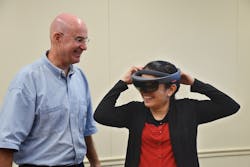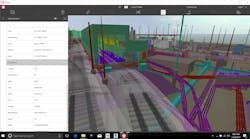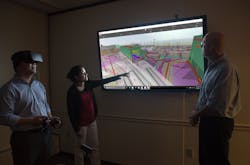Living in your design
Engineers are well-versed in using 3-D design tools and imagery to carry out their designs and display their work.
Still, it’s like watching a scene through a window—you see it, but you cannot experience the fullness of what is taking place. By putting designs into a virtual reality (VR) or augmented reality (AR) interface, engineers can enable themselves, their clients and stakeholders to climb through that window and truly live their designs by “walking” through the projects they are delivering, whether it’s a bridge, tunnel, or wastewater or flood mitigation system.
The ability to take this step has become a reality as engineering firms use VR and AR to better their designs and serve their clients’ needs. Every stage of a project—from the first day of planning to the final day of construction—can be improved thanks to this technology.
VR and AR: What’s the difference?
VR and AR were first made popular by video gamers. Over time, the concept has transformed healthcare, the military, sports and education by enabling training experiences that are much closer to real-life situations. The VR/AR market is set to grow at an extraordinary rate; Goldman Sachs predicts it to rise to a base market of $80 billion by 2025, with 3.2 million users and $4.7 billion in software revenues coming from the engineering industry.
VR immerses users into an imagined (not life-like) or simulated (life-like) environment that they can directly interact with and explore. The user typically must wear a headset with screen and audio capabilities that provide the visual and auditory cues, along with hand-held controls or gloves fitted with sensors that enable the user to immerse themselves and even manipulate the environment they experience through the headset. A good example of the application of VR technology is a designer creating a bus terminal and using VR to create an experience in which visitors can experience the full journey: Arriving to the terminal by cab or car, discovering and locating the entrance, going through ticketing and security, to the gate and so on.
AR overlays or integrates computer-generated video, graphics, sound and/or GPS data into the user’s real environment, allowing them to experience or interact with it. One example of using AR technology in the design field would be the construction of a new water treatment facility. By using AR interfaces, not only will the building model be placed onto the site in real time, it will allow the users to interact with how the building fits into the construction site, including how parts and systems that have yet to be created will fit in contrast to those that have already been built.
In short, VR offers an experience of an alternate (virtual) environment while AR modifies (augments) one’s perception of their real-world environment.
Virtual reality headsets, such as the one pictured, pair visual and auditory cues to provide either imagined or simulated environments.
Applying VR and AR to the AEC industry
Even though some may see VR and AR as technology for gaming and entertainment or simply a cool marketing tool, they are already proven assets for planning, design development, training and public outreach in the architecture, engineering and construction industries. The technology allows engineers and stakeholders to more effectively communicate about the design and collaborate before implementation, and even conduct “on-site” assessments, prior to any construction.
At the 2017 American Public Transportation Association Expo, numerous vendors set up VR displays. Gannett Fleming gave attendees a tour of its completed $65 million Denver Commuter Rail Maintenance Facility, a 237,000-sq-ft facility that provides a safe, temperature-controlled environment to repair, clean and store train cars. Whether at a tradeshow or a client meeting, walking through a site allows a first-hand experience of the project that cannot be achieved through traditional models and renderings.
Public involvement is one arena in which VR or AR can enable stakeholders to get a true picture of an emerging project impacting their community. Instead of showing a 2-D model at a town hall meeting of how trees may be used to reduce noise congestion, community members can put on a headset that allows them to see those trees grow over time and experience the resulting noise reduction.
VR and AR also can be applied to project planning and development. Every project brings different considerations with it, and being able to integrate all the available data sets in a single virtual interface can help with scope identification, work flow concepts, equipment selection, illustrating design intent, and conflict identification and resolution.
Let’s look at another real-world example, like building a bridge over a river. Light Detection and Ranging (LiDAR) survey data can be combined into a VR model with all other datasets gathered for the project, including drone imagery, point cloud information, traffic and signal timings, and utilities overlaid on top. With all the information integrated into one interactive interface, project movements, timelines and potential conflicts may be easily identified and mitigated, thus allowing for successful, on-time, and on-budget project completion.
Training is another common use of VR and AR in the AEC industry. For example, several companies are utilizing VR and AR to help develop the skills of drivers for all types of fleets. In the construction industry, it is being used to train workers on operating man lifts, snow plows and other heavy maintenance vehicles.
Survey data can be integrated into a VR model, along with other data sets, to render one interactive 360° interface.
Tomorrow’s technology
Perhaps the most exciting part of the VR and AR revolution is that the future uses in the engineering field are endless. VR and AR can help to solve some of our most common issues, such as surveying and construction of projects in perilous or hard-to-reach locales.
According to the American Wind Energy Association, the installed capacity for wind power in Washington State in 2016 was 3,075 megawatts, with wind power accounting for 7% of the electricity generated in the state. The state ranks among the top 10 in terms of cumulative wind capacity. This power is generated from countless wind turbines built on remote wind farms. In the future, it may be that engineers inspect the turbines simply by deploying a drone enabled with the ability to capture and transmit virtual footage back to the inspector in combination with all the necessary variables from different data points monitored by “smart city” technologies. Bridge inspections could be conducted in an equivalent manner. No more time- and travel-intensive site visits.
Think of the possibilities of using VR or AR programs for planning highway, bus rapid transit (BRT) or rail line projects. Employing these interfaces would provide a means to get operators’ input early in the design process, present design options and coordinate utility runs in one combined program that is easily accessible to all.
Imagine if a city wants to increase its BRT program. Using data like traffic and signal timings and street view, VR and AR could be used to show and simulate different bus routes, diverse and varying schedules, traffic pattern and possible conflicts. The best options for bus routes and schedules could be established by employing these simulations.
In construction management and design-build projects, VR and AR could be used for facilitating inspections, developing phasing plans, construction sequencing, conflict detection and constructability review and documentation. With VR or AR, the entire project could be uploaded by phase into the system and the inspectors could monitor progress, complete inspections, and provide feedback without visiting the site.
VR and AR also can be used to bridge the impending institutional knowledge gap resulting from the retirement of the baby-boom generation. The Journal of Business Studies Quarterly reported that industries are losing their most experienced talent as employees retire or move on to part-time employment. VR or AR training can be used to provide tutorial and apprentice-like experiences. It even has the potential to allow trainers to join the mentee(s) on the job without having to be on-site, simply by enabling the mentee to record and transmit the environment to the mentor.
VR or AR capabilities could allow bridge engineers to pull up the design and operations manuals needed to conduct work on a bridge, as well as walk and talk through the project site with other experts, prior to even starting the work. Conducting these exercises from your office saves time, coordination, money and transportation.
VR/AR is presently useful for project demonstrations and design planning, as shown here.
Walking through the window
The applications of VR and AR in our industry are rapidly evolving: cloud-based VR apps, AR overlays guiding the work of robotics on construction sites, and error-free human performance thanks to ubiquitous AR wearables.
From current uses in public involvement, project development and training, to future uses in planning and design, construction management and additional training opportunities, companies cannot afford to ignore these technological advancements.




